June Berry Tree
 June-berry, Service-berry, Shad-bush (Amelanchier Canadensis T.&G.)-A slender, round-headed tree, rarely 40 feet high, usually less than 20 feet. Bark smooth, purplish brown, with pale lenticels. Wood heavy, hard, dark brown. Buds pointed, brown, inner scales elongate in spring. Leaves alternate, oval or oblong, serrate, tapering, smooth; 3 to 4 inches long, midrib grooved above and ridged underneath.
June-berry, Service-berry, Shad-bush (Amelanchier Canadensis T.&G.)-A slender, round-headed tree, rarely 40 feet high, usually less than 20 feet. Bark smooth, purplish brown, with pale lenticels. Wood heavy, hard, dark brown. Buds pointed, brown, inner scales elongate in spring. Leaves alternate, oval or oblong, serrate, tapering, smooth; 3 to 4 inches long, midrib grooved above and ridged underneath. Flowers, April, before leaves, white in loose, drooping racemes, with silky bracts, 1 inch across with 5 narrow, long petals. Fruit, June, a red, juicy, sweet berry, with 10-celled core. Preferred habitat, rich, upland soil, borders of woods. Distribution, Newfoundland to the Dakotas, south to the Gulf. Uses: A desirable park or lawn tree; wood occasionally used for tool handles, etc.
Do you wait until you are sure of finding violets a-plenty before you take the time to go to the woods? Then you miss a rare and most delightful experience. Go two weeks earlier this year, and you may see the little June-berry tree put on her bridal veil. The larger trees which stand about with naked branches are but a background to set off the charms of this modest woodland beauty.
It is not simply by contrast with the barrenness around it that this tree delights the beholder. The soft, graceful, feathery clusters and the individual, starry blossoms would be attractive at any season. But that flowers so delicate should unfold so early, while yet winter lingers, is a marvel that goes straight to the heart. You break the sprays that lean toward you as if in invitation, and carry them home with a sense of personal gratitude.
What makes one feel a glow of warmth when looking at this tree? The sharp spring air does not justify it. There is a faint undertone of colour that takes off the chill of the white cloud of blossoms. Looking close we see that the strap-shaped bracts are red, a pair of them below each flower, and the tinge is deepened by the red-brown of the silky infant leaves, which hang limp and helpless, their two halves folded on the midrib, and quite obscured by the mass of bloom.
In summer the leaves are not distinctive. They are daintier than those of the apple and pear, and have not the hydrocyanic acid odour of the foliage of plums and cherries. The twigs lack the thorns characteristic of the hawthorns. So, by elimination, we may be able to identify this tree among the multitude of its relatives.
The fruit cluster is a good clue all summer long, though the birds take the berries so promptly that it is exceptional good luck if you find a ripe one on the tree. But the long branching stems which bore the sweet morsels are held out empty, or with dry, undeveloped berries upon them, longer and looser in structure than the racemes of the cherry group.
Showy as it is in blossom, the June-berry is never a selfassertive tree. Its flowers are gone as suddenly as they came, and the little tree quite loses its identity when the forest wakes and covers itself with a dense thatch of green. Cloistered thus, and cut off from the benefits of wind and sun, no wonder that the tree ordinarily rises little higher than a thrifty shrub.